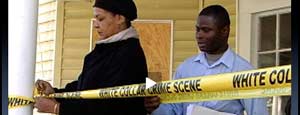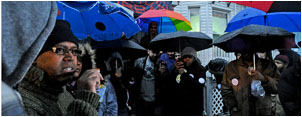
In her Monday post, Mass Humanities’ Pleun Bouricius wrote about We Shall Not Be Moved, my on-going project to document the grassroots struggle against foreclosure in Boston. In her post, she talks about the challenges presented by the project, which walks a fine line between advocacy and humanities. In creating and presenting the project, I’ve heard it referred to as art, advocacy, documentary, journalism, and history, and while I think it contains elements of all of these, I’m not sure that it lands firmly in the territory of any one. But in the process of wrestling with boundaries and definitions, I think it has been my relationship with Mass Humanities that has helped me ultimately arrive at a framework that hopefully presents more questions than answers.
In 2008, I saw some videos of a series of “eviction blockades” happening in Boston. On the day a family was scheduled to be evicted, a crowd of 50 or so people would show up in front of their house early in the morning. A picket line would form on the sidewalk; a smaller group of protestors would chain themselves on the front steps of the house, refusing to move when the constable and movers arrived. Sometimes the eviction was cancelled or postponed, but on a couple of occasions, arrests were made and the family was evicted amid chants of “Shame” from the crowd. At that point, I knew very little about the families and organizations behind the blockades, but the fact that they were happening seemed like an important piece of local history evolving around the economic crisis, and I decided to explore the story.
When I approached City Life/Vida Urbana, the lead organization behind the blockades, I told them I was interested in their work and asked for permission to observe their weekly meetings. I quickly realized how little I knew about the foreclosure crisis. Like many media consumers, I had heard lots of homeowners were “underwater” in their mortgages, though I didn’t quite know what that meant. I heard that foreclosures were on the rise, and I was barraged with images of foreclosure: empty houses, For Sale signs, overgrown yards. But completely devoid of people.
And yet here was a room full of people, standing up one after the other, saying their name and quietly announcing that their home was in foreclosure. Here were people who had lost the ability to keep up with their mortgage payments months or even years ago, and yet here they were, holding on to their homes and holding on to each other, united by a single act: they had decided not to leave.
As the weeks went on and the room grew more crowded, I tried to make sense of the story. At the meetings, I was hearing about the legal process of foreclosure and eviction, learning about cash for keys and Notices to Quit. Outside of the meetings, I was reading about fixed versus adjustable rate mortgages and financial products like the Option ARM and the NINJA loan. With my nonexistent background in economics, I was quickly feeling in over my head.
I had decided that one way to tell a story about this crisis and this movement would be to follow a series of families through the process of foreclosure and whatever followed. As I talked to people about their cases, the details piled up before me: complicated loans moving from one bank or mortgage company to another, interest rates jumping, trails of paperwork sent but never received. And the complex web of family, job, health, and general life events that contributed to whatever crisis they were experiencing.
I struggled with nailing down the details of each case: loan amounts, interest rates, incomes, monthly payments, home values, all of which seemed like moving targets. I had a sense that if I could just figure out the numbers, I could discover some greater truth about the subprime mortgage crisis.
When I connected with Pleun Bouricius at Mass Humanities in early 2010, I was still trying to answer this question of how to tell the whole story. With her guidance, I was able to take a step back, and start to see that telling the whole story means more than just detailing a series of complicated financial transactions. The whole story involves generations of history leading up to today’s reality. Today’s story involves case after case of people being encouraged, misled, manipulated, and even defrauded into taking out mortgages that they can’t afford. A longer history reveals generations of discriminatory lending patterns in which race and class have been used as risk factors in determining availability of mortgage loans. Today, working class people are being judged as trying to live beyond their means by participating in the mid-2000s home-buying frenzy. A longer view exposes the construction of homeownership as the best path to wealth, family security and the American Dream, even as large segments of the population were being systematically denied access to that dream.
For me, the most surprising and interesting element of the story has been to bear witness as people find their own identity as historical actors within that longer view. In my interviews with people facing foreclosure, I consistently heard them talk about finding strength in connecting with others who were facing the same challenges, and how those connections helped them move beyond their own fear and shame. But the most powerful moment was hearing people talk about the act of telling their own story, out loud, in public, and how that simple act had changed their lives. By choosing to speak out and to engage in collective action, they are creating their own foothold in an evolving history of American radicalism and resistance.
challenges, and how those connections helped them move beyond their own fear and shame. But the most powerful moment was hearing people talk about the act of telling their own story, out loud, in public, and how that simple act had changed their lives. By choosing to speak out and to engage in collective action, they are creating their own foothold in an evolving history of American radicalism and resistance.
Ultimately, I realized that by trying to tell the whole story in one neat little package, I was ignoring the nuance, complexity and contradictions that make our history so compelling. With the help of Mass Humanities, I settled into the framework of focusing on what I found most unique and engaging about the human experience of this moment in history. In the end, I hope that, rather than presenting conclusions, this project contributes some new insights to the public discourse around the current economic crisis, while at the same time acknowledging the unanswered questions as we watch history unfold before us.


